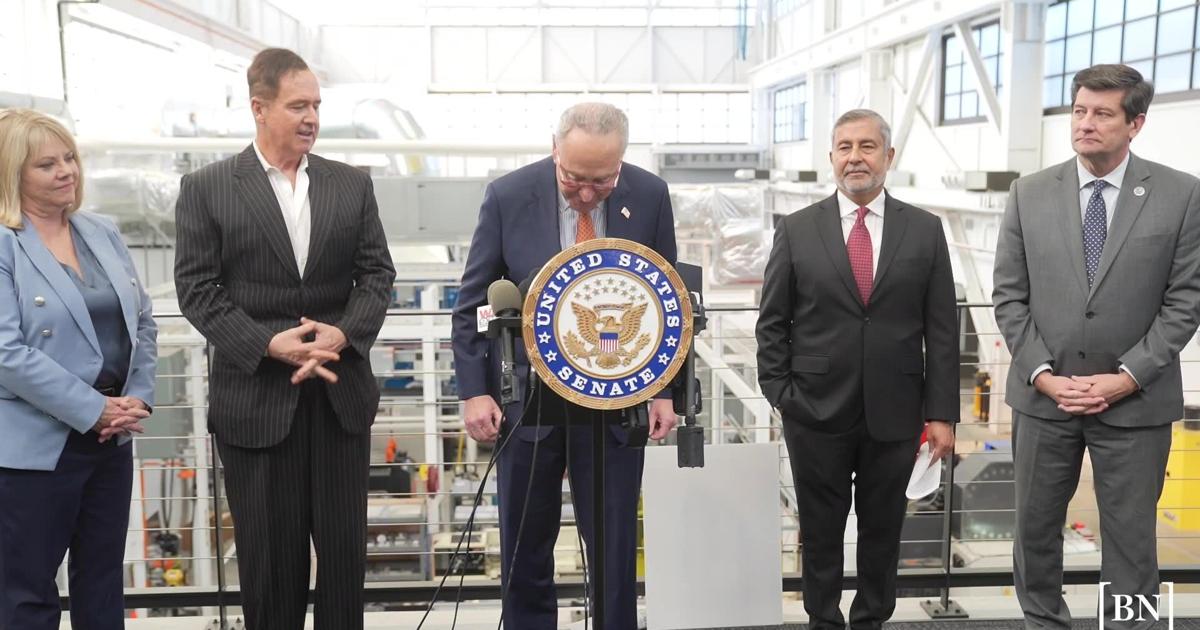The “tech hub” bid submitted by Buffalo, Rochester and Syracuse plans to use about $54 million in federal funds to bolster the semiconductor industry in upstate New York.
Now, the three-region team will wait to find out if its entry is deemed worthy of funding, in a competition overseen by a federal agency.
If the money comes through, New York State has committed an additional $10 million to support the plans to bring the total value to about $64 million.
The joint bid, created under the NY SMART I-Corridor banner, would create a “semiconductor corridor” from Buffalo to Syracuse.
It is an industry in the spotlight, with Micron Technology announcing a chip fabrication plant near Syracuse worth up to $100 billion, and Edwards Vacuum planning a $319 million facility in Genesee County to support chip plants.
People are also reading…
On top of those projects, there’s a clamor to increase domestic manufacturing of semiconductors, with the overwhelming majority of chips currently made overseas.
The NY SMART tech hub bid would seize that opportunity, with plans to train workers, build up a network of suppliers, promote innovation and attract capital. Notably, the plans rely heavily on collaboration between Buffalo, Rochester and Syracuse, rather than competition among those regions.
The vision is to not only attract new employers, but to create growth opportunities for existing companies, and to prepare area residents for high-paying jobs in the sector.
If the $54 million is awarded, the impact on upstate would be “transformational,” said Joseph Stefko, president and CEO of ROC2025, an alliance of economic development groups in Rochester.
“This gives us an opportunity to make some strategic and targeted investments to position us to lead the way and ensure that future innovation goes through our region,” Stefko said.
The Buffalo-Rochester-Syracuse bid cleared a big hurdle last year, when it was designated one of 31 “tech hubs” out of about 400 entries in a competition overseen by an agency of the U.S. Commerce Department. The 31 tech hubs are eligible for tens of millions of dollars in federal funding, but only five to 10 of those applicants are expected to be awarded money.
In this latest round, the tech hubs had to explain how they would use the federal funds to foster high-tech development. The application deadline was Thursday. The U.S. Economic Development Administration is expected to announce funding decisions this summer.
Dottie Gallagher, president and the CEO of the Buffalo Niagara Partnership, said she sees funding from the program as akin to “seed capital,” supplemented with other sources of funding to fully achieve the plans. But the $54 million – along with the pledged $10 million from the state –would activate the plans.
The tech hub program was created as part of federal legislation championed by Sen. Chuck E. Schumer, D-N.Y. The Senate majority leader has been a vocal advocate for the Buffalo-Rochester-Syracuse bid.
Now that NY SMART has submitted its proposals, Schumer said he will go “all out” to ensure the entry wins funding.
Schumer listed what he called the Buffalo-Rochester-Syracuse bid’s “great selling points” for succeeding: its workforce, abundant water, cheap power, research institutions and the Senate majority leader on its side.

Senate Majority Leader Chuck Schumer, left, looks on as Sanjay Mehrota, CEO of Micron Technology, speaks in Buffalo last October. Micron Technology has announced a chip fabrication plant near Syracuse worth up to $100 billion.
Each of the three regions would lead one of the initiatives in the tech hub’s plans. But the three regions would also play roles in the initiatives they do not lead, Gallagher said.
“It’s not, ‘What are you getting? What am I getting?’ she said. “It’s like, ‘What is the challenge? Who is best to lead this part of the solution?’ “
The Partnership, ROC2025 and CenterState CEO in Syracuse spearheaded the development of the tech hub proposals. More than 100 partners contributed to the effort, including universities, labor, government, businesses and nonprofits.
Here are the five proposals, with the projected budget and lead organization for each:
- STEP UP—Semiconductor Talent and Employer Partnership, about $17.5 million, led by Monroe Community College in Rochester. Its focus is workforce training and increasing access to semiconductor job opportunities for people historically excluded from tech and manufacturing job opportunities.
The STEP UP initiative would focus on “closing that skills gap and preparing more workers and connecting with more historically underrepresented communities to fill that talent gap,” Stefko said.
STEP UP would serve as a “unified front door” for employers to find talent to fill semiconductor jobs, he said.
This initiative would leverage the $200 million proposed by Gov. Kathy Hochul to promote workforce development in the corridor, Stefko said.
C3—Commercialization and Collaboration Center, $15 million, led by Syracuse University. C3 would focus on commercializing new semiconductor technologies.
C3 would help businesses of all sizes gain access to upstate New York’s research and development facilities, said Benjamin Sio, senior vice president of strategy, policy and planning for CenterState CEO. Many of these facilities already have some level of connection to the semiconductor industry.
C3 would subsidize access to facilities for prototyping for small and minority-owned businesses. It would also host semiconductor innovation conferences and fund semiconductor-related research, internships and co-ops.
SCALE—Semiconductor Advancement, Leadership and Entrepreneurship initiative, $15 million, led by Empire State Development’s Division of Science, Technology and Innovation. This would provide seed funding to semiconductor firms in the three-region territory, and hands-on support for entrepreneurs.
SCAN—Supply Chain Activation Network, $8 million, led by the University at Buffalo. SCAN would build up the supply chain network for the semiconductor industry, through both existing and new companies.
“It’s not just about attracting new suppliers into the region,” Gallagher said. “It’s really about helping local manufacturers who are close or adjacent to the supply chain for semiconductors to actually adjust their businesses and invest in that.”

Dottie Gallagher, president and CEO of the Buffalo Niagara Partnership, likens $54 million in federal funds to “seed capital” for upstate’s semiconductor industry.
The idea is to support existing companies that have stuck it out in New York State through difficult economic circumstances over the years, said Robert Simpson, president of CenterState CEO.
“Making investments and helping those companies access the markets created by the semiconductor opportunity is actually one of the things we all feel like is really important, to pay their loyalty forward,” Simpson said.
- Innovation office—$6 million. This initiative, led by Stefko, would involve partners from all three regions, continuing the theme of collaboration. The office would provide governance for the plans, track equity goals and identify whether any changes need to be made along the way.
Schumer championed the legislation that led to the creation of the tech hub program and has called for ramping up domestic semiconductor manufacturing.
“This is going to be a huge shot in the arm for the Western New York economy,” Schumer said.
Schumer said he has repeatedly made his case to Commerce Secretary Gina Raimondo.
“I must have spoken to her 30 times on this issue, as recently as Tuesday night,” he said, adding that he is “very optimistic” that the bid will receive funding.
Four other tech hubs in the competition also based their bids on semiconductors. Schumer said upstate New York has already demonstrated its ability to attract semiconductor manufacturing and related development, which he believes strengthens its chances.
“We have shown we are a good place to locate, even before this (tech hub) designation and before these dollars,” he said.
“It’s been my dream to sort of turn the economy of Western New York and upstate New York around,” Schumer said. “We’ve had some successes already, but this is going to really hit a home run for us.”












